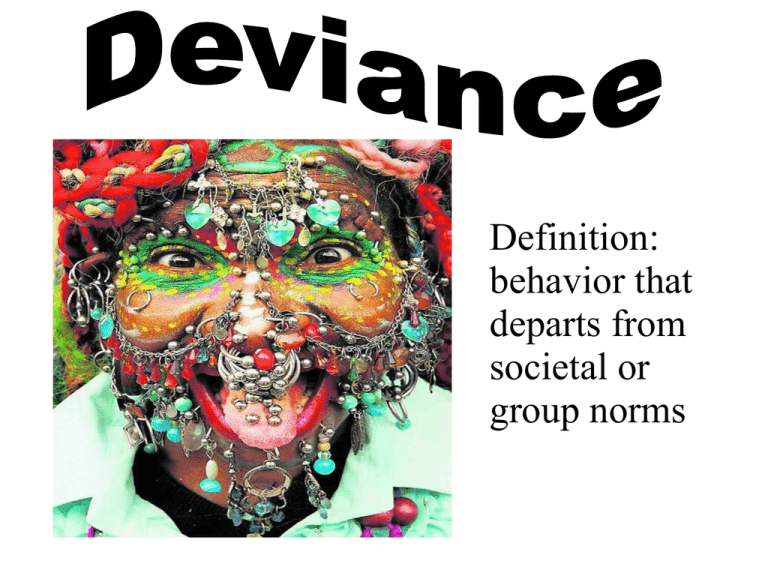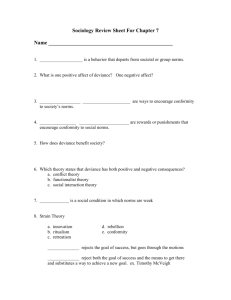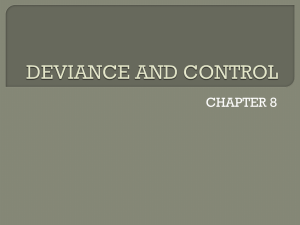Deviance & Social Control: Sociology Presentation
advertisement

Definition: behavior that departs from societal or group norms Social Controls Ways to encourage conformity to society’s norms. Without Social Controls life would be unpredictable or chaotic Norms Def: rules defining appropriate and inappropriate behavior. Example: Everyone in an elevator faces the door and not each other. Sanctions- rewards or punishments that encourage conformity to social norms Positive Sanctions Def: Intended to encourage acceptable behavior. Ex: Child says thank you and the mother smiles Negative Sanctions intended to discourage unacceptable behavior Speeding Ticket Nasty look Strain Theory- something blocks someone from obtaining their goals so they turn to deviance 90% of high school seniors have been accepted to college. 5% do not want to go to college and the remaining 5% want to go but cannot for whatever reason. All students want to be successful and college is generally the first step in achieving that goal. The 5% who want to attend but were blocked may act in a deviant manner since they feel cheated by society. Anomie- feelings of being disconnected from society Innovation- people find illegal ways to succeed. Ritualism- acts as if you want to succeed but do not exert much effort towards success Retreatism- stops trying to achieve success Rebellion- makes up their own way for achieving the goal because they do not accept the status quo Conformity- most people accept the social norms and how we achieve the good life is through hard work and education Control Theory- resist the pressure to become a deviant Attachment- the stronger the attraction to the group the more likely you are to conform Commitment- the greater your commitment to the social group the more likely you are to conform Involvement- participation in approved social activities increases the probability of conformity Belief- belief in the norms and values promotes conformity Differential Association Theory- adolescence learn deviance from the group for which they associate with. An adolescent changes schools and his new peer group smokes marijuana, the new student is more likely to smoke marijuana. On the other hand, if a student moves to a new school where no one smokes marijuana, he is less likely to take up the habit. Labeling Theory : theory that society creates deviance by identifying particular members as deviants Unwed teenage mothers are labeled as deviants even though the unwed teen father is not stigmatized Middle class youth who steal a car receive less of a punishment than a lower class youth who steals a car because we expect the lower class youth to be a “criminal”. Primary Deviance Deviance involving occasional breaking of norms that is not a part of a persons lifestyle or self-concept Ex: An adolescent who smokes cigarettes with other adolescents is not at risk of being labeled a deviant among her peers, since they all smoke. Even though adolescents who smoke cigarettes are considered deviant by the larger American society, that teenager’s actions go relatively unnoticed, unpunished, and therefore unchanged. The primary deviance is of little consequence. Secondary Deviance - deviance in which an individuals life and identity are organized around breaking society’s norms Ex:The same adolescent moves to a new school where his peers never smoke and where smoking is considered a deviant behavior. The students call him names and exclude him from all of their social activities. Because of their reactions to his smoking, he feels like an outcast and begins to smoke more, perhaps engaging in other deviant activities, such as alcohol or drugs. Conflict Perspective Theory Theory which looks at deviance in the terms of social inequality and power. Most powerful members of society determine who and what is deviance. the elite can often afford expensive lawyers and are sometimes on a first-name basis with the individuals in charge of making and enforcing laws. Members of the working class generally do not have these advantages “Celebrity law” Victim Discounting process of reducing the seriousness of the crimes that injure people of lower status. If a victim is less valuable the crime is less serious and penalty is less severe If a prostitute is raped and beaten to death the crime is not viewed as awful as it would be if a student at Dulles was raped and beaten to death. Crime: acts committed in violation of the law A. White Collar Crime- job related crimes committed by high status people. They are less likely to be imprisoned. If convicted they are sent to federal prisons with tennis courts and private rooms. B. Deterrence- discouraging criminal acts by threatening punishment C. Incarceration- a method of protecting society from criminals by keeping them in prison D. Rehabilitation- process of changing or reforming a criminal through socialization. 30-60% return to prison within 2-5 years of being released. Types of Crime Crimes against peopleviolence, threatening (ex) mugging Crimes against propertytheft, damage (ex) arson Victimless crimes- laws are violated but no victim is identified (ex) prostitution





